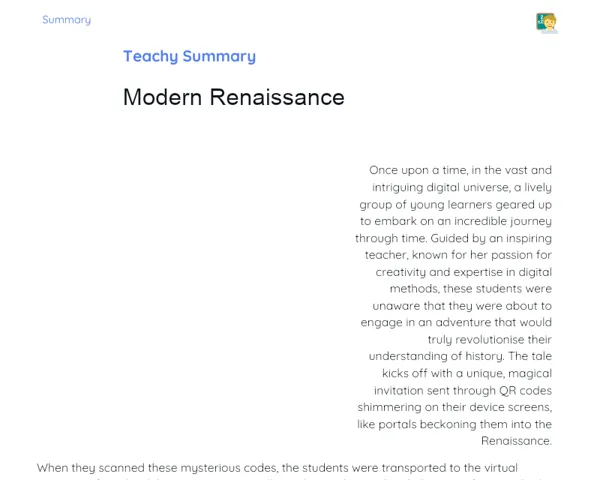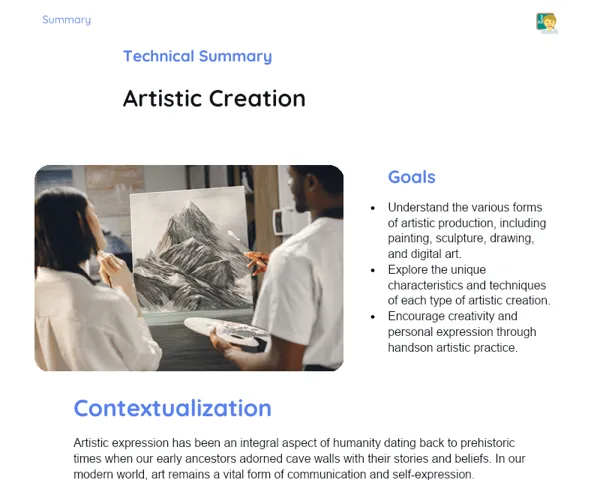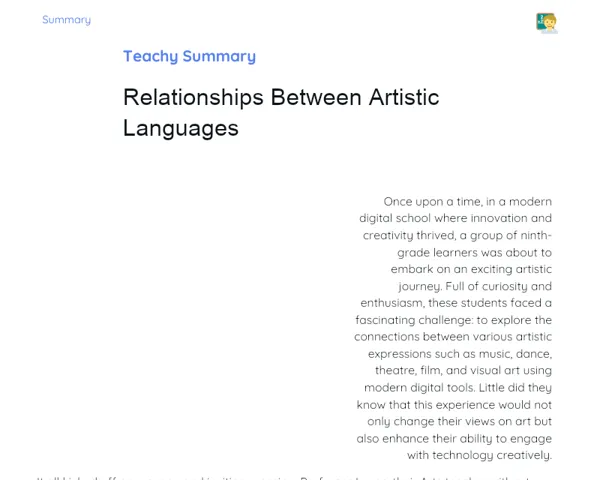Socioemotional Summary Conclusion
Goals
1. Recognise dance as a form of expressive art and explore various dance styles.
2. Understand how movement can reflect and influence different emotions.
3. Develop the ability to express feelings through body movement, using dance techniques.
Contextualization
Did you know that dance is one of the oldest forms of human expression? From traditional rituals to contemporary dance competitions, movement has always been a powerful way to convey emotions, share stories, and connect with one another. Let’s delve into how your body can serve as an amazing tool for communicating emotions!
Exercising Your Knowledge
Dance Movement
Dance is an art form that makes use of the body’s movement in a rhythmic and expressive manner. This component focuses on understanding how the body can create patterns, shapes, and expressions that convey emotions and narratives. Dance is a unique means of self-expression and non-verbal communication, allowing dancers to explore and share their feelings.
-
Body Movement: The foundation of all dance, involving the coordinated use of different body parts to create expressive movements.
-
Patterns and Rhythms: Dance often follows specific patterns and rhythms that enhance the emotional storytelling.
-
Emotional Expression: Various movements and dance styles can encapsulate a wide range of emotions, from joy to sadness and anger.
Elements of Movement
The elements of movement comprise the basic components that form dance. These include space, time, force, and shape. Each element plays a crucial role in generating unique and meaningful movements that express emotions and narrate stories. Understanding these elements is vital for anyone involved in dance, as it fosters greater awareness and control over how movement is executed.
-
Space: Refers to the area where movement happens, including direction, level, and path. The use of space can significantly influence how the audience interprets a dance.
-
Time: Involves the speed and rhythm of movement. Quick movements may convey excitement or anger, while slow movements can express calmness or sadness.
-
Force: Relates to the energy and intensity of movement. Strong, dynamic movements might suggest power or determination, whereas gentle movements can emit delicacy or vulnerability.
-
Shape: Refers to how the body's positions and movements appear. Shapes can create figures and patterns that amplify the emotional narrative of a dance.
Emotional Expression in Dance
Emotional expression in dance revolves around the intentional use of movement to convey feelings and emotional states. This aspect is crucial for developing social and emotional skills, allowing dancers to explore their own emotions and express them in a constructive manner. Additionally, the capacity to interpret and understand the emotions of others through dance enhances empathy and communication skills.
-
Non-Verbal Communication: Dance facilitates the expression of emotions without needing words, making it a powerful mode of communication.
-
Empathy: Observing and taking part in dances that express diverse emotions can help learners develop empathy, gaining a better understanding of others' emotional experiences.
-
Self-Knowledge: Through dance, students can delve into their own feelings, recognising and naming emotions they might not have previously articulated.
-
Emotional Regulation: Practising dance can support students in developing skills to manage and express their emotions appropriately.
Key Terms
-
Dance Movement: The use of the human body in rhythmic and expressive patterns.
-
Elements of Movement: Components such as space, time, force, and shape that form the foundation of dance.
-
Emotional Expression: The ability to convey feelings and emotions through body movement.
-
Non-Verbal Communication: The expression of ideas, feelings, and emotions without using words.
-
Empathy: The ability to understand and share the feelings of another person.
-
Self-Knowledge: Awareness of oneself, including understanding one's own emotions and behaviours.
-
Emotional Regulation: The ability to manage and respond appropriately to various emotional states.
For Reflection
-
How can you use dance to express an emotion you’re currently feeling? Describe the movements you would incorporate and elaborate on your choices.
-
Recall a time when you witnessed a dance that stirred your emotions. Which elements of movement contributed to your feelings? How did those aspects enhance the emotional expression of the performance?
-
How might practising dance assist you in improving your emotional regulation in other areas of your life? Provide specific examples where these skills could benefit you.
Important Conclusions
-
Dance is a powerful art form that employs body movement to express emotions and narrate stories.
-
Different movements can reflect a variety of feelings, aiding in non-verbal communication and self-awareness.
-
The elements of movement, such as space, time, force, and shape, are fundamental in developing meaningful and engaging dances.
-
Practising dance fosters socio-emotional development, enhancing empathy, emotional regulation, and social skills.
Impacts on Society
Dance movements significantly influence our contemporary society. For instance, on social media, we witness how dance can go viral, bringing together people from diverse cultures and backgrounds. Global dance styles are shared, learned, and adapted, which promotes a better appreciation of cultural diversity. Additionally, many young individuals utilise dance as an outlet for expressing their emotions and tackling everyday emotional challenges.
On a personal note, dance provides a healthy and creative medium to handle stress and anxiety. When we move our bodies, we release endorphins, which elevate mood and energy levels. Thus, regular dance practice can be an invaluable resource for emotional and mental well-being, acting as a channel for feelings that are often hard to verbalise.
Dealing with Emotions
To manage your emotions while exploring dance and its applications, I recommend an exercise rooted in the RULER approach. First, take a moment to Recognise how you feel when practising or observing dance. Next, attempt to Understand the cause of that emotion and its potential effects. Label that emotion clearly – is it happiness, frustration, excitement? Then, express that feeling through a specific movement or a short choreography. Finally, find ways to Regulate that emotion by identifying healthy coping mechanisms, whether through dance, meditation, or having a chat with someone you trust.
Study Tips
-
Try practising various dance styles at home and pay attention to how each one makes you feel. Create a short choreography expressing a specific emotion.
-
Watch videos featuring both professional and amateur dancers. Focus on the elements of movement and emotional expression, and note what stood out to you.
-
Keep a dance journal to capture your experiences, feelings, and reflections after practising or observing a dance. This will help reinforce your learning and deepen your understanding of your emotions.



